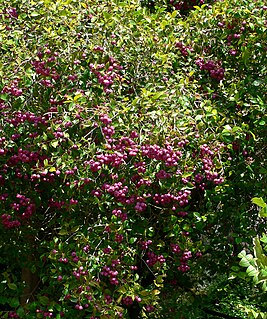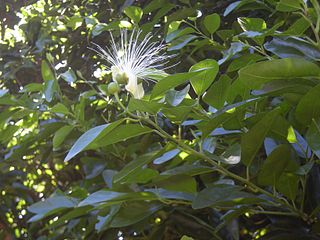
Alphitonia is a genus of arborescent flowering plants comprising about 20 species, constituting part of the buckthorn family (Rhamnaceae). They occur in tropical regions of Southeast Asia, Oceania and Polynesia. These are large trees or shrubs. In Australia, they are often called "ash trees" or "sarsaparilla trees". This is rather misleading however; among the flowering plants, Alphitonia is not closely related to the true ash trees, and barely at all to the monocot sarsaparilla vines (Smilax).

Annona glabra is a tropical fruit tree in the family Annonaceae, in the same genus as the soursop and cherimoya. Common names include pond apple, alligator apple, swamp apple, corkwood, bobwood, and monkey apple. The tree is native to Florida in the United States, the Caribbean, Central and South America, and West Africa. It is common in the Everglades. The A. glabra tree is considered an invasive species in Sri Lanka and Australia. It grows in swamps, is tolerant of saltwater, and cannot grow in dry soil.

Syzygium smithii is a summer-flowering, winter-fruiting evergreen tree, belonging to the myrtle family Myrtaceae. It shares the common name "lilly pilly" with several other plants. In New Zealand, it is commonly known as 'monkey apple'. It is planted as shrubs or hedgerows, and features: rough, woody bark; cream and green smooth, waxy leaves; flushes of pink new growth; and white to maroon edible berries. Unpruned, it will grow about 3–5 m (9.8–16.4 ft) tall in the garden.

Syzygium luehmannii is a medium-sized coastal rainforest tree native to Australia. Common names include riberry, small leaved lilly pilly, cherry satinash, cherry alder, or clove lilli pilli.

Alphitonia excelsa, commonly known as the red ash or soap tree, is a species of tree in the family Rhamnaceae. It is endemic to Australia, being found in New South Wales, Queensland, Northern Territory and the northeastern tip of Western Australia. It is used in bush regeneration as a pioneer species and for amenity planting.

Cryptocarya triplinervis is a rainforest tree growing in eastern Australia. Common names include the three veined laurel, three veined cryptocarya and the brown laurel.

Dendrobium linguiforme, commonly known as the thumbnail orchid, tick orchid or tongue orchid, is a plant in the orchid family Orchidaceae and is endemic to eastern Australia. It grows on trees or on rocks, with wiry, prostrate stems, prostrate, fleshy leaves and spikes of up to twenty white to cream-coloured flowers in early spring.
Stenocarpus cryptocarpus, known as the giant leaf stenocarpus, is a species of trees, of the plant family Proteaceae. It is endemic to some rainforest parts of the wet tropics region of north eastern Queensland, Australia. Notably, juvenile leaves of young trees may reach 115 cm (4 ft) in length.

Capparis arborea is a bush or small tree occurring in eastern Australia. The habitat is rainforest; usually riverine, littoral or the drier rainforests. Distributed from the Hunter River, New South Wales to Cape Melville in tropical Queensland. Common names include native pomegranate, wild lime, wild lemon and brush caper berry.

Atalaya multiflora, known as the broad leaved whitewood, is a rare and endangered rainforest tree of the soapberry family native to eastern Australia.

Petalostigma triloculare, known as the long-leaved bitter bark is a rainforest tree of eastern Australia. It occurs in the drier rainforests, often on sandy soil derived from granite or sandstone, and is sometimes seen on old sand dunes.

Planchonella queenslandica, the blush condoo, is a large rainforest tree of the family Sapotaceae native to eastern Australia. It's found in sea side rainforest as well as the drier inland rainforests. From as far south as the Richmond River, New South Wales to Coen in tropical Queensland, and as far west as Melville Island, Northern Territory.

Bosistoa floydii, commonly known as the five-leaf bosistoa or five-leaved bonewood, is a species of small rainforest tree that is endemic to north-eastern New South Wales. It has pinnate leaves usually with five elliptic leaflets, and panicles of tiny, creamy white flowers.

Alphitonia petriei, known as the white ash, is a rainforest tree in the family Rhamnaceae. It grows in eastern and northern Australia. Other common names include red ash, white-leaf, pink almond and pink ash. It was originally collected from the Johnston River near Kuranda, and named in 1925 by K.W. Braid. The authors gave it the species name petriei after W.R. Petrie, who alerted them to its distinctness.

Dysoxylum pettigrewianum, commonly known as the spurwood, is a species of large tropical rainforest tree in the family Meliaceae. Found in Queensland, New Guinea, Solomon Islands and Malesia. In Queensland it is found in the wet tropics from Rossville near Cooktown in the north, southwards to Tully.
Canarium muelleri, commonly named scrub turpentine or mangobark, is a species of Australian rainforest trees in the plant family Burseraceae. They are endemic to northeastern Queensland, widespread in the rainforests of the Wet Tropics region, and further south to the Conway Range area, near Proserpine, Queensland.
Syzygium forte, commonly known as white apple, flaky-barked satinash or brown satinash, is a tree of the family Myrtaceae native to Western Australia and the Northern Territory.
Lasjia whelanii, also known as Whelan's silky oak, Whelan's nut oak or Whelan's macadamia, is a species of large forest tree in the protea family that is endemic to north-eastern Queensland, Australia.
Memecylon pauciflorum is a tree species in the Melastomataceae family. It grows as a tree or shrub in northern Australia and tropical and subtropical Asia. An understorey species typically, it grows in a variety of communities. The possum Petropseudes dahli uses this species as one of their scent-marking sites. It is a host to a number of funguses. People in Australia and in Thailand use the plant in folk medicine, though no efficacy has been demonstrated.














